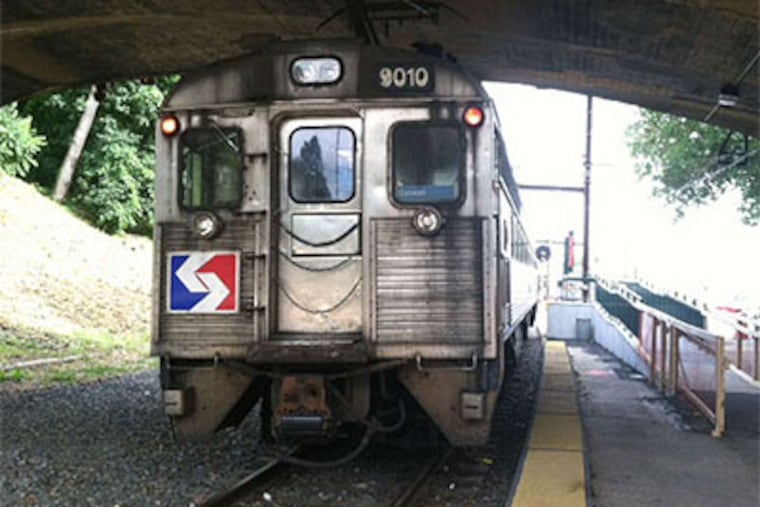SEPTA to scrap the last 'Silverliner II'
When Train 9010 rolled into service in 1963, carrying Philadelphia-area commuters on the Reading Railroad, it was part of a revolution in railroading.

When Train 9010 rolled into service in 1963, carrying Philadelphia-area commuters on the Reading Railroad, it was part of a revolution in railroading.
The self-propelled train was part of a new fleet of "Silverliner II" cars built by the Budd Co. in Northeast Philadelphia, purchased for the financially ailing Reading Co. and the Pennsylvania Railroad by the city.
The stainless-steel marvels "were an entirely different way of commuter travel," said Larry DeYoung, historian of the Philadelphia chapter of the National Railway Historical Society. "They were air-conditioned. They were much lighter, they rode better, they used less electricity, and, believe it or not, the seats were more comfortable," he said.
"And, obviously, they were really durable."
On Friday, after a half-century and millions of commuters, Train 9010 will make its last run.
Now dressed in the livery of SEPTA, its air conditioner still muttering cantankerously, its dirty red and yellow seats considerably less comfortable than they were, the last surviving Silverliner II will make the 20-minute trip from Suburban Station to Cynwyd before being sold for scrap for $23,000.
Its slightly younger kin, the last Silverliner III, made in 1967 by the St. Louis Car Co., will also make its final trip Friday, also on the Cynwyd line.
A new generation of 120 SEPTA cars, Silverliner V's, are taking their place, built in South Korea and assembled in South Philadelphia by workers for Hyundai-Rotem Corp.
With the departure of the old Silverliners, the legacy of manufacturers like Budd, once an innovative industrial powerhouse and major employer in Philadelphia, fades a little further.
There are still Budd cars on other railroads, including Amtrak and the PATCO High-Speed Line. But the famous Philadelphia company that made train cars, as well as aircraft and auto components, has disappeared in a series of acquisitions, mergers, and spin-offs.
The once-thriving Budd plant on Red Lion Road that employed about 2,500 workers was demolished in the late 1990s, giving way to a golf course that is now closed.
Budd's sturdy Train 9010 will depart largely unmourned, except among the fraternity of rail buffs. Many passengers had grown weary of sagging, threadbare seats and balky air-conditioning, mechanics were tired of scavenging or making replacement parts, and SEPTA managers had run out of federal waivers of handicapped-accessibility regulations to keep the old Silverliners in service.
The waivers will expire Saturday, forcing the cars' retirement.
"I don't think we'll want to keep them around," SEPTA spokesman Andrew Busch said. "They will be scrapped."
A Newark, N.J., scrap yard will pay about $23,000 each for the old Silverliners.
"It's just a piece of equipment," engineer Jim Conway said unsentimentally while operating 9010 on a run to Cynwyd on Wednesday. He noted that, unlike the passenger compartment, the cab had no air-conditioning.
On second thought, Conway said, there was something he'd miss.
"They have the best heaters in the world. I want them to take the heaters out of these and put them in the [Silverliner] IVs."
The Reading nameplate that used to adorn the side of the car has been gone for many years, and so has the plate that noted that the car was owned by the city's Department of Public Property.
The only clue left to the car's storied origins is a small plate on each of the doors that says: "Budd Co. Builders. Morrison-Knudsen Co. Inc. Rebuilders. 1989." Those were installed when the cars were refurbished, 27 years after they were built.
By then, Budd was already out of the railcar business. The company that had invented a process for welding stainless steel and had built 6,834 railcars at the Red Lion plant had returned to its earliest roots and was concentrating on the automotive industry.
And by then, it was no longer in local ownership, having been acquired in 1978 by German manufacturer Thyssen A.G.
Budd ended railcar production in 1987 and sold its rail designs to Bombardier Transportation.
When Thyssen merged with Krupp in 1999, Budd Thyssen became ThyssenKrupp Budd Co. Late in 2006, its auto body and chassis operations were sold to Martinrea International Inc. of Ontario.
"Budd sort of evaporated," said DeYoung, the historian. "There's no residue left here."
Except on the rails.